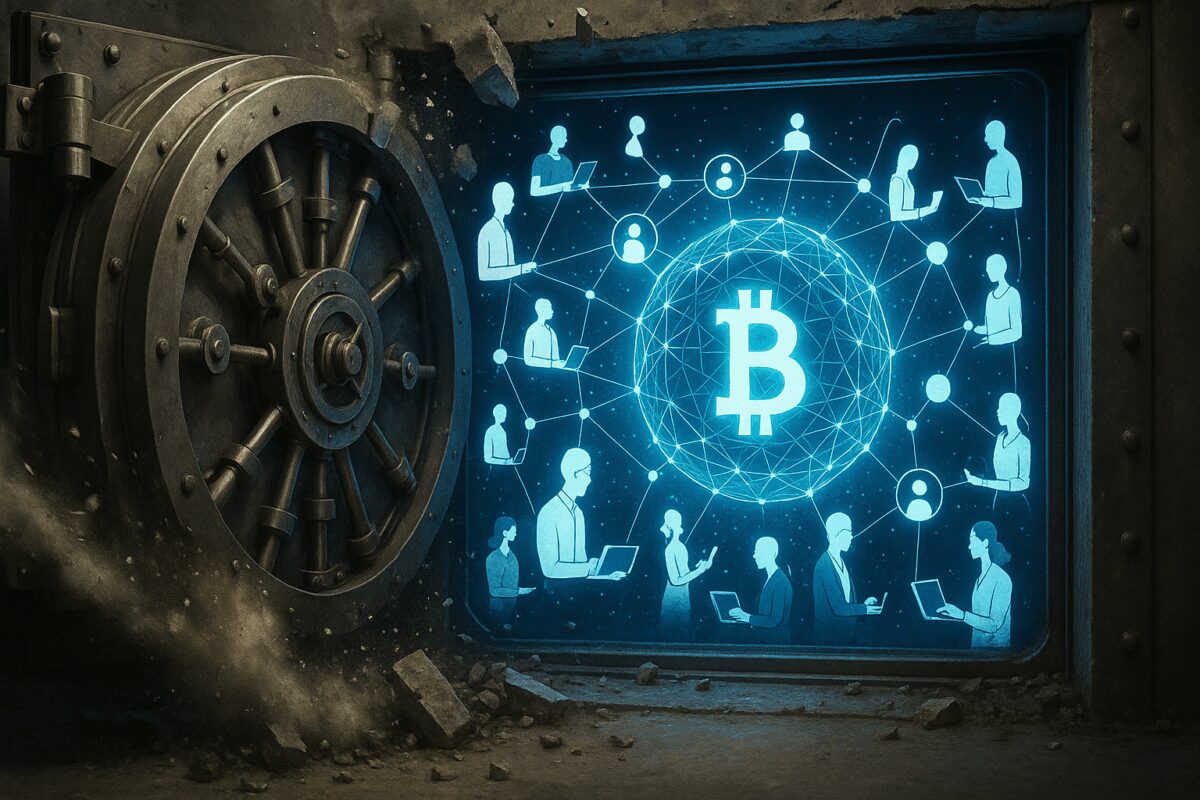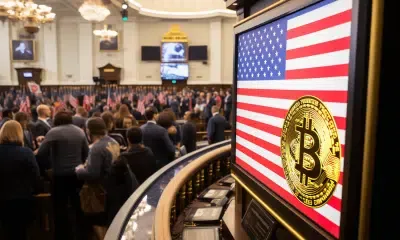
DeFi Unmasked: Diving into Finance’s New Playground
What is DeFi, and why is it changing the way we think about money? Once just a curious idea within crypto circles, Decentralized Finance (DeFi) has exploded into a lively financial world, shaking up how we think about old-school money. Blockchain is its foundation, letting DeFi create financial tools that anyone can see, use, and join in on, covering a huge range of money matters. The main goal here is to cut out the usual middlemen like banks or stockbrokers. Instead, DeFi uses smart contracts, which are like little computer programs on a blockchain that run themselves, to keep financial dealings safe and smooth.
DeFi dreams of opening up finance for everyone. Picture a world where having internet means you can use financial tools, no matter where you live or how much money you have—totally different from the old system where big players often decide who gets in and who doesn’t.
What Makes DeFi Tick: The Core Ideas
DeFi’s whole setup rests on a few big ideas:
- No Single Boss: Control is spread out everywhere, making it hard to shut down and letting people deal directly with each other.
- Doors Wide Open: Pretty much anyone can jump in to use or even create stuff on DeFi. Usually, all you need is the right kind of crypto wallet, which skips a lot of old hurdles.
- See-Through Operations: What happens and how the systems are built is mostly out in the open on the blockchain, which helps people feel they can trust it.
- Written in Stone: Once a deal is confirmed on the blockchain, it’s there for good and can’t be changed, making records really solid.
- Mix and Match Magic (“Money Legos”): Think of DeFi tools as Lego pieces. Coders can snap different services together to cook up brand new financial gadgets because they all live on the same blockchain playground.
- You Hold Your Own Keys: Generally, you’re in charge of your own money through special wallets, not some company—a big change from how banks usually work.
- Automatic Money Moves: These smart contracts are like digital vending machines; they automatically handle financial tasks once certain rules are satisfied, cutting down on people needing to step in.
All this is designed to make things run smoother and cheaper by cutting out the middlemen. But remember, DeFi is still new and exciting, so it comes with its own dangers like coding mistakes, wild price swings, and tricky government rules.
DeFi vs. Old-School Finance: What’s the Big Difference?
| Feature | Traditional Finance (TradFi) | Decentralized Finance (DeFi) |
|---|---|---|
| Backbone | Central systems, private books, familiar big companies | Spread-out networks, public digital books, smart computer programs |
| Getting In | Often need permission, stuck to certain places, set hours | No permission needed, works everywhere, always on, just need web & a wallet |
| Go-Betweens | You rely on banks, brokers, and rule-makers | Tries to skip most old go-betweens; people connect through code |
| Who’s in Charge? | Big companies look after the money | You usually look after your own money directly |
| Openness | How things work can be a bit secret | Deals are usually public for anyone to check |
| New Ideas | Changes happen slowly, held back by rules & old systems | Lots of quick experiments and new versions coming out all the time |
| The Rules | Lots and lots of rules | Rules are still being figured out, which means new chances and new risks |
Under the Hood: DeFi’s Tech Building Blocks
What makes DeFi tick? A few core pieces of tech are crucial:
- Blockchain Smarts: Think of shared digital record books, like Ethereum or Solana. These are the base where all deals are logged and checked so everyone can see them and they can’t be messed with. Ethereum is a big player because its smart contracts are so powerful, but others like Solana are catching up by being faster and cheaper.
- Smart Contracts: These are the little programs that do the work automatically – from handling loans on Aave to trading tokens on Uniswap. Because they can be combined, different DeFi tools can work together, sparking quick new ideas.
- Code-Based Safety: Fancy math tricks like secret codes (encryption) and digital handshakes (signatures) keep your deals and info safe, building the confidence needed for DeFi to work.
- Data Bridges (Oracles): These are important helpers that safely bring outside information, like current prices of things, into the smart contracts. This lets the contracts respond to what’s happening in the real world. Systems like Chainlink try to make sure this data is trustworthy by not relying on just one source.
The DeFi Playground: What Can You Do?
- Crypto Trading Hubs (DEXs): Places like Uniswap or PancakeSwap let you swap digital money straight from your own crypto wallet. They use clever systems called Automated Market Makers (AMMs) and pools of funds that other users provide.
- Digital Lending & Borrowing: Tools like Aave and MakerDAO let folks lend out their crypto to get some interest back, or borrow crypto if they put up something as security. The interest rates are usually set by computer programs.
- Steady Digital Cash (Stablecoins): Coins like USDT, USDC, or the more independent DAI try to keep their price steady, often by linking to something like the U.S. dollar. This is super important for making DeFi dealings less like a rollercoaster.
- Earning Extra Crypto (Yield Farming & Staking): People can get rewards by adding their crypto to different DeFi services (that’s “farming”) or by locking up their tokens to help run the network and vote on things (“staking”), usually getting new tokens as a thank you. A popular twist is “liquid staking” (think Lido), which lets you use your staked money elsewhere while it’s still locked up.
- Safety Nets for DeFi (Decentralized Insurance): Services like Nexus Mutual provide a way to get protection if something goes wrong in DeFi, like a coding bug getting exploited or a stablecoin losing its dollar link.
Market Check-Up: Growth, Users, and What’s Predicted
DeFi is making a big comeback. By May 2025, about $117.856 billion was locked up in DeFi services, a key measure called Total Value Locked (TVL). Just earlier in 2024, this TVL jumped 116%, going from around $62 billion to $134 billion. Experts think it’ll keep growing, with some guessing the market could hit anywhere from $178.63 billion by 2029 to maybe even $1,558.15 billion by 2034.
More and more people are using DeFi too; the number of crypto wallets active each day supposedly hit a new high of 24.6 million near the close of 2024—that’s a 485% jump from the year before. Trading on those decentralized exchanges (DEXs) has boomed, and some think the total amount traded might go over $4 trillion before 2025 ends.
What’s pushing this growth? Big things like turning real-life items (think property or bonds, called RWAs) into digital tokens, more big investment companies getting curious, clever tech (Layer 2s) that makes DeFi run better, and DeFi just getting easier for everyday folks to use.
Why People Are Excited: DeFi’s Good Sides
- Easier for Everyone to Join: DeFi tries to knock down the old walls in finance, making its tools available to pretty much anyone who can get online.
- Everything’s More Open: You can usually see most DeFi deals and the code behind them right on the blockchain, which keeps things more honest.
- You’re in Charge: Holding your own crypto means you call the shots with your money, so you don’t have to depend on go-betweens as much.
- Quicker and Cheaper: By making things simpler and getting rid of some of the usual players, DeFi could lead to speedier deals and smaller charges.
- New Ideas Pop Up Fast: Because its different parts can snap together like “money Legos,” new financial tools can be invented really quickly.
Watch Your Step: The Challenges in DeFi
Even with all its exciting possibilities, DeFi has some big obstacles to clear:
- Code Glitches: Mistakes or weak spots in the programming can be used by attackers, sometimes causing people to lose a lot of money. Checking the code (audits) is important, but it doesn’t catch everything.
- Hidden Costs from Transaction Shuffling (MEV): The folks who build blockchain blocks, or others watching closely, can sometimes rearrange or slip in deals to make extra cash for themselves. This can mean you pay more or get a worse deal, like a hidden fee.
- Unclear Rules: Because DeFi is spread out and people can be somewhat anonymous, governments around the world are still figuring out how to handle it, making the legal situation a bit murky and always changing.
- Wild Price Swings: The crypto money involved can jump up and down in price like crazy, which affects how much your security (collateral) is worth and could even force your loans to be closed out.
- Traffic Jams and High Fees: Some blockchains get really busy and charge a lot for each transaction, which makes using them a pain. Newer “Layer 2” tech is trying to help fix this.
- Tricky to Use: Figuring out crypto wallets, “gas” fees for transactions, and how all the different DeFi apps work together can be pretty confusing, especially if you’re new.
- A Weird Kind of Loss (Impermanent Loss): If you put your crypto into those automated market maker pools to help others trade, you might end up with less value than if you’d just held onto your original coins, especially if their prices move apart a lot.
- Not Always as Decentralized as It Seems: Getting everything truly spread out and not controlled by a few—from the basic tech to how decisions are made, what users see, and where data comes from—is really tough. Sometimes, control ends up in fewer hands than you’d expect.
What’s Next? Keep an Eye On These DeFi Trends:
- Digital Versions of Real Stuff (RWA Tokenization): Turning things from the physical world, like houses or company IOUs (bonds), into digital tokens on the blockchain is a huge area for growth. It connects DeFi with everyday finance.
- Making DeFi Run Smoother (Layer 2s): Tech like “optimistic rollups” and “ZK-rollups” are super important for helping DeFi handle more people and transactions, without costing a fortune or taking forever.
- Group-Run Projects (DAOs): More and more, DeFi projects are being run by these groups called DAOs, which make decisions and manage money. Still, they’re figuring out how to be quick and get enough people to vote.
- Blockchains Talking to Each Other: Getting different blockchains to easily share money and information is key for DeFi to feel like one big connected system.
- Going Greener: People are paying more attention to how much energy blockchains use. Ethereum, for example, switched to a system called Proof-of-Stake, which cut its power use way down.
- DeFi for Big Players: New tools and services are popping up specifically for large investment firms. These try to blend DeFi’s fresh ideas with the rules and safety features big money needs.
The Path Forward: DeFi Going Big Time
For DeFi to really take off with everyday people, it needs to get past the problems it faces now. Top of the list are making things super secure with thorough checks and advanced methods, getting clear rules from governments, making it way easier to use, and ensuring it can handle tons of users smoothly.
DeFi is also mixing with digital collectibles (NFTs), games where you can earn crypto (GameFi), and virtual worlds (the Metaverse). This blend is sparking new ways to make and manage money and helping DeFi reach more people, sometimes even using NFTs as security for loans in DeFi.
DeFi probably won’t kick old-school finance to the curb immediately, but it’s definitely shaking things up, pushing new ideas forward, and showing us what a more open, slicker, and customer-first money world could look like. We’ll likely see DeFi and the usual finance systems (CeFi) start to work together, borrowing the best bits from each. How big a deal DeFi becomes really boils down to whether the folks building it can get people to trust it, keep it safe, and show it truly helps a lot more folks out.




